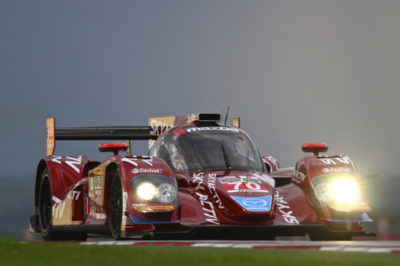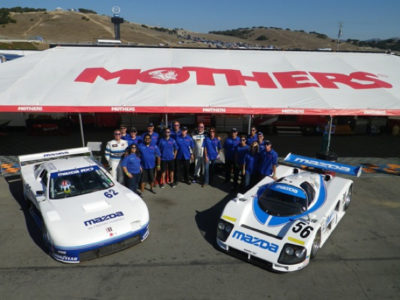Sylvain Tremblay compares the 1991 Mazda 787B and the current Mazda SKYACTIV Diesel Prototype.

There’s no doubt that racing technology, like every facet of technology, has advanced rapidly in the last two decades. Although to a casual observer, a prototype racer from the early ’90s may not look vastly different from a current closed-cockpit prototype sports car, the differences are significant. SpeedSource owner Sylvain Tremblay got a firsthand lesson in just how much things have progressed when he recently drove a Mazda 787B at the Monterey Motorsports Reunion at Mazda Raceway Laguna Seca.
The 787B’s most notable achievement was winning the 24 Hours of Le Mans in 1991. The 787B that Tremblay drove was the sister to that winning car and finished eighth that same year. Compared to the Mazda SKYACTIV Diesel Prototype that Tremblay currently drives in the TUDOR United SportsCar Championship, the 787B is a delightfully uncomplicated machine.
“The car is very simple, very elegant and very purposeful,” Tremblay explains. “I was really impressed by how simple and elegant the aerodynamics were. It has a huge picnic-table-size wing on the rear of the car, but not many more aero add-ons. It’s the shape that creates the downforce. It has rather large tunnels, but they’re very simple compared to our current prototype. Not much of the aero bits we have to channel or function the air. It’s basically a doorstop shape, and that’s how it makes its downforce.”
If the simplicity of the aerodynamics are impressive, the sparseness of the cockpit made an even bigger impact on Tremblay. While the cockpit canopies on prototypes then were low and wide, now they are typically narrower.
“The cockpit was probably the most surprising, how spacious it is for a prototype compared to the very narrow confines of our current prototype. The switchgear was well laid out, it made sense – a bunch of switches to control some of the engine electronics. The steering wheel is probably the most amazing part. It has one button on it. One. Which is for the radio. Our steering wheel looks like a video game. It has knobs, switches…you have to go to school to learn about it and all the information that goes through that particular wheel. It was refreshing to have one button on the steering wheel,” he says.
Aerodynamics and instrumentation are certainly more advanced than they were 20 years ago. Engines are too, but often in a different way. The SKYACTIV Diesel is geared toward efficiency. Winning at Le Mans in 1991 required power – a lot of it. And the four-rotor R26B was designed for that singular purpose.
“What a wonderful creation this engine is. It pulled extremely strong from 5000 all the way up to its mandated 8500RPM redline – which turns the dash red. For a rotary guy, you always want to be near the redline anyway. It sounded great, it idled right up and I didn’t really have any concerns with drivability. The adjustable intake runner length that Mazda had really perfected for the R26B, you could see why it was so good, because the engine really had no dead spots when you were in the power band. The three-rotors we ran in the GT cars were very peaky; these were not. The variable intake trumpet length was probably the magical solution why the cars were so nice to drive.
“The sound, the music that this engine makes, was probably the best part of the experience for me. I’ve always loved the sound of a rotary, and this one was definitely a master tone in its tuned, four-rotor state,” Tremblay adds.
It all adds up to what Tremblay describes as a riot to drive. “You really have to drive this car. It doesn’t have the hand-of-God downforce that the current cars have, but that’s what makes the car fun. You have to toss it around and slide and it’s much more of a driver’s car than our current car. I loved the chance to drive it and I would jump at the chance to do it again,” he says.
Tremblay got a little bonus at the Reunion, also. Because the 787B wasn’t able to make one of the races, he had the opportunity to drive the RX-792P that competed in IMSA GTP. That car was developed even further than the 787 and with even more power.
“It has 50 to 75 hp more than the 787 and so much downforce it’s unbelievable,” Tremblay enthused. “That was fun to do. I had the opportunity to start on the pole position and ended up winning the morning race on Sunday and, having never driven the car nor even sat in it, it was a surreal experience. You could see how good the car could have been if Mazda had continued with that particular package. It’s a beautiful piece of Mazda history and I was honored to have the opportunity to drive it.”
Video Bonus: Sylvain Tremblay drives the 787B at the 2014 Monterey Motorsports Reunion at Mazda Raceway Laguna Seca.


 ACCESSIBILITY
ACCESSIBILITY